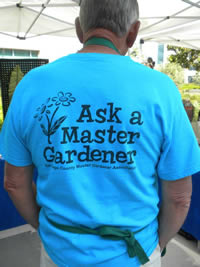How to Write the Perfect Master Gardener Hotline Question
By Cindy Bruecks, Hotline All-Star
 Often when I work the MG Hotline, I get a question something like this:
Often when I work the MG Hotline, I get a question something like this:
“The leaves on my lemon tree are turning yellow. What is the matter?”
The question was sent from an iPhone, and the author was probably in a bit of a hurry. Still, it raises so many questions in my mind.
- Where is this lemon tree? Jamul is so different from Encinitas which is so different from Poway. The location gives me clues as to the climatic conditions that I can’t infer from just the simple question. We had a spate of extreme hot weather a month back, and I’m aware of some of the temperature records that were challenged or broken. But I can’t use that knowledge without some notion of location.
- How old is this tree? I recently heard a similar question about a very young tree. If the tree has not had adequate time to put out a root structure beyond what was in its nursery pot, it is at higher risk of water stress (see next question) and its tender young growth is a veritable magnet for pests of all kinds. If it’s long-established, those considerations likely won’t apply, but the next two questions are key for the older tree. So again, I can’t give a blind recommendation without more information.
- How does the tree get watered? If it’s on drip, that’s one thing that might give consistent irrigation. If it’s hand watered, I always wonder how much water it gets and how often (and generally in this case, the questioner doesn’t really know). But I have no clue from the brief question. Irregular irrigation can result in more than split fruit. Overwatering can bring on yellowing of the foliage, but is that the case here? And if the tree gets watered like a lawn, oh dear, it’s time for the “deep and infrequent” lecture.
- Is the tree fertilized, and if so, how, how often and with what? Citrus are heavy feeders. Plant food can make a huge difference in the growth and productivity. I like to recommend any good commercial citrus food, giving 1/3 of the recommended dose quarterly in Spring, Summer, and Fall. Read the instructions on the bag. Give the tree the winter off so it can rest and not push (frost-tender) new growth. Again, this is more important inland and at higher elevation, less so near the coast. I know some folks don’t want to ”get so involved” with their plants. They want a simple, pared-down regimen and that’s OK too. But if you want to grow fruit trees, they do take a bit of care to grow into healthy, productive adults. And a tasty harvest is worth the effort.
Now you understand why I’m not able to confidently answer the posed question. I need more information, as outlined above. I can give my usual “good sense” reply, which is to treat the tree well, avoid stressors, and monitor it to be sure you catch any insect infestation early. So that we can best help answer your Hotline questions, try to frame them with as much useful info as possible. And please also include a photo, which is simple to do from a smart phone. A picture really is worth a thousand words.

